People who’ve known me since I was a kid are always surprised when I write about liking mushrooms. Because as a youngster, it was the one ingredient that I truly despised. Now, in my defense, until I was in my late teens, my only experience of mushrooms were those that came from a can, either in whatever preservative watery substance they were “canned” or in cream of mushroom soup, the latter showing up in my mother’s “green bean casserole” at holiday times. Even the first restaurant I worked in, starting in early high school, used canned ones on pizzas and pastas. It wasn’t until I dutifully and respectfully tried a stir-fry prepared by an aunt that involved fresh mushrooms, that I discovered that they weren’t of inherent character, brownish-grey and slimy.
Enter into our vignette, Donnet, Av. Jorge Newbery 4081, Chacarita, a spot that has been garnering much attention for its devotion to the world of fungi, and in particular, that it does so with a strict vegan ethos, and draws praise from non-vegan writers. The chef-owner, Manuela Donnet, doesn’t make a point about the restaurant being vegan, but rather pushes the mushrooms to forefront, and the place has become known in the gastronomic world as “the mushroom restaurant”. Although not a Horde outing, a quartet of us who have been at the core of the near weekly lunch group gathered one evening to check the place out. (Although basically empty when we arrived, it filled up quickly – an hour after this photo the place was packed.)
The menu is a whimsical affair. With hand-drawn cartoons of dishes, most of them not much clearer than the drawing of a human being at the end of a “hangman” game, and with no descriptions, just a name of a dish. Nor am quite sure what the intent of the gleaming molar on the cover of the menu is meant to signify. You either take your chances or you interact with one of the two charming and fun waiters, who have taken individual expression to heart – ours the more staid of the two with a floral print shirt, culotte length jeans, painted nails and makeup, the other attending to tables in short-shorts and bared chest. Even the cooks are in the open kitchen in their own array of colorful attire.
Now, the menu, given that there’s little to read, doesn’t take long to peruse – there are only three appetizers and two main courses available, plus an option to try the “Experiencía”, in which each person gets a plate with a sampling of a small amount of each thing on the menu. It was quickly noted in conversation, however, that with four of us, it would actually be less expensive to order one full dish of everything on the menu, even the day’s special and the desserts, neither of which are a part of the Experiencía, and just share them all. So we did.
We drank kefir, that sparkling fermented beverage that’s usually dairy based, but here in a vegan spot, the first time I’ve encountered “water kefir”, made in-house from kumquats. The particular fruit used changes regularly. We loved it, and went through two bottles of it. There are, also, wine and beer available.
The first dish to arrive was the “vegetable stew” – a puree of what tasted like squash and carrots. It had a nice depth of flavor, but was desperately lacking in salt. A request for the latter made to Ms. Donnet when she visited the table bringing the next dish was met with, “if you knew how much salt I put in that, you’d know that adding more you’d be killing yourself”, and she walked away. We were not brought salt. We weren’t thrilled. And, as one of our number quipped, in keeping with general spirit of the place, “Hey lady, my body, my rules”. Didn’t get us any salt. I don’t know that there are any mushrooms involved in this dish, and didn’t think to ask.
The second dish, that she’d brought us herself, was the daily special – a coconut and spice, somewhat Thai-ish broth with “red mushrooms” – they looked a bit like some sort of pinkish version of oyster mushrooms, but not sure exactly what they were. We didn’t get an explanation of the little pearls of orange and black, and they had little flavor. Overall, we liked this dish, but it had a bitter note that wasn’t quite balanced, and again, needed some salt. Hmmm…
The house version of fainá, the locally ubiquitous chickpea flatbread that can be found at virtually any pizzeria. Now, normally, the ingredients are chickpea flour, parmesan cheese, salt, and water. Maybe a little pepper. That’s it, so one could easily make fainá just substituting in something like “rawmesan” (a parmesan substitute made from grinding together nutritional yeast, raw pumpkin seeds, turmeric, and salt), and in fact, this does use that, but for some reason, instead of chickpea flour, uses some sort of fermented seeds as a substrate, and then tops it all with sauteed green squash. It was fine, but didn’t really taste like fainá. We’re getting a touch restless and wondering if ordering the entire menu was such a good idea after all.
On this one, we were split. A black mushroom (just one, re-hydrated, floating there in the back) and black bean (there might have been half a dozen) soup. It had a huge tangle of some sort of sprouts in it. My description was that it tasted like dirty dishwater, with less flavor. Two of our number kept more or less silent on it. The fourth, and the one who’d asked for salt on the first soup, lapped it all up happily. Strange to me, as I found this one to be the blandest dish of everything we had. So be it. At this point, we’re discussing where we might go for food afterwards, as we know we only have the two main courses remaining – there’s a bar a block away that catches our eye….
And then, this arrives. the specialty of the house, the eponymous Hongos Donnet, and, for a brief, shining moment, all four of the previous dishes are forgotten as we revel in the flavors and textures of what might be one of the best mushroom dishes I’ve ever had. Portobello mushrooms, marinated in “green olive liqueur” – something I didn’t even know existed, but have now found out where to obtain, because I’m going to be playing with that in the future – and then roasted and lacquered in that liqueur, served over a fermented cashew puree that was tangy, creamy, and a perfect foil to the portobellos, along with dehydrated seed crackers – which there’s no way to make sound appetizing, but they simply are – crunchy, seedy, salty (hey, there we go), and just plain yummy. No wonder Ms. Donnet, in interviews, has said that this dish “pays her rent”. Because if for no other reason – go to Donnet and have this dish.
The other main course arrives, and only pales by comparison to the previous one, because it, too, is absolutely delicious. Roasted oyster mushrooms that have been drizzled with fresh lemon, and accompanied by a trio of platos voladores, “flying plates”, one a sort of oyster mushroom escabeche, another a little fresh salad of frisee, orange peel, and roasted chickpeas, and the third, a sort of coconut-y sprout relish. We’ve now more or less forgotten about the appetizers, as well as going to the bar down the block. We even briefly consider ordering another round of the main courses, but…
… move on to the dessert sampler plate – none of us are big dessert eaters, so ordering one of each dessert isn’t in the offing. I have to admit, I don’t recall what it all was – I know there was a banana sorbet served with a little cup of chili syrup that was brilliant, as was the gold thing in the front, which is a chocolate wrapped beet mousse of some sort, there’s a chocolate mousse-like scoop as well, I don’t recall what the orange one in the back is. The two chocolate bon-bons felt a bit gratuitous alongside the other desserts, and were a bit difficult to share, but we were in our happy place by this point, so it didn’t matter.
So, in the end…? I like the place, I like the service, though not the refusal to provide salt (again, “our bodies, our rules”). I loved the two main courses and the desserts. The two soups were, for me, in dire need of seasoning, be it salt or something else, but they were just bland as could be. The fainá was fine, if not really fainá. The daily special appetizer had great potential but was just missing some balancing element to really bring it out, and again, needed some salt. It was all very reasonably priced – we had all of the above dishes, plus two bottles of kefir, and adding in a tip, we each only shelled out 650 pesos, basically $11 (the “Experiencía” that would have given us each a taste of only some of these dishes, runs 665 pesos on its own). Would I go back? Yes. I’d happily go back for either of the main courses, for the kefir, and even to try whatever daily special might pop up.
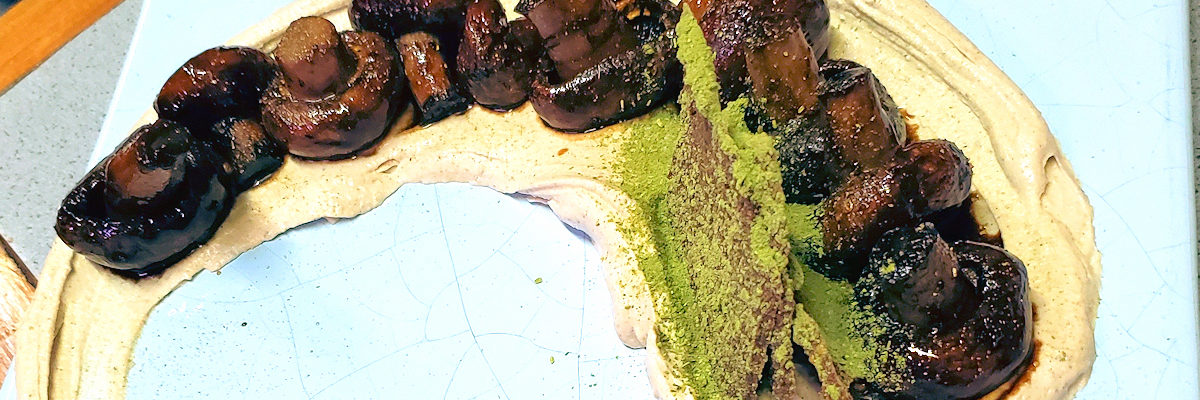
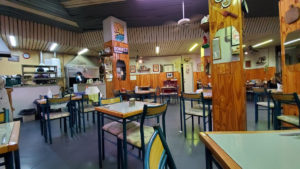

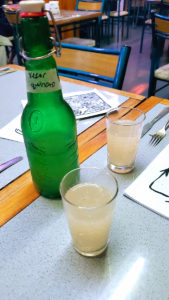
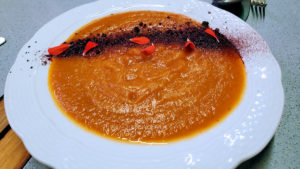
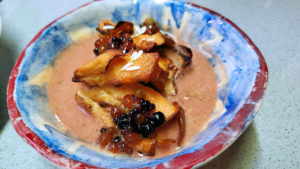
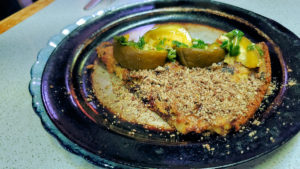
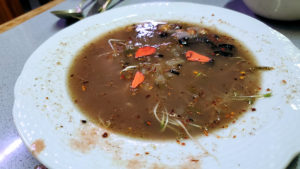
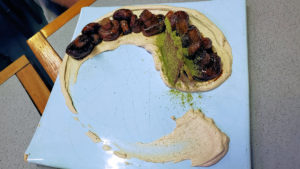
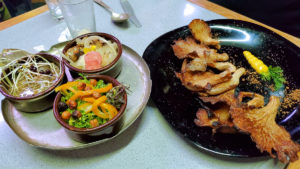
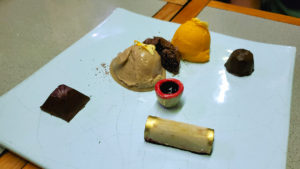
thanks Dan! ade me want to go!!
Interesting review. Admittedly, I had never heard of this place despite having installed Happy Cow, a sort of Vegan and Vegetarian Trip Advisor. You can check out the website version (free) here if you are curious about it: https://www.happycow.net/
Judging by the look of your plates, maybe the molar on the menu stands for ‘nothing to crunch on’. But I am purely guessing, as Argentines have a weird taste for food place names and an odd sense of humor.
I love mushrooms and I think that fried porcini are the best. Of course, they are nowhere to be found here, neither dehydrated or fresh. I did little experimenting with local mushrooms, and so far my favorite are girgolas (oyster mushrooms), that I bake or fry. I can’t find them in the City, though. I had a supplier in Mar del Plata (Etienne from Mangez-moi: https://www.facebook.com/pg/mangezmoihongos/posts/) and bought one kilo of fresh. They were dirty cheap and so tasty!
It caught my attention that you mention parmesan in the fainá. I never noticed they put parmesan on the fainá here and it shouldn’t be there. I make fainá at home myself, and it tastes just like in ordinary pizza places here. Are you sure about it? There are places offering fainá with topping, but the standard version is plain chickpea flour, water, salt, oil. And then some ground pepper to taste.
I don’t like the attitude of the no-more-salt lady. The cooking rule is very simple: salt, you can always add it but never take it out, so be moderate and eventually add.
Plus, different people have different sensitivity in the tastebuds (for example, smokers tend to eat saltier and more sweet). On this account, due to a dental surgery I am temporarily chewing on the left side of the mouth and I can barely taste anything. I move to food to the right, and the flavor is all there. Weird!
I’m quite sure about the parmesan – it’s not on, it’s in, the mix. Not everyone does it, but it’s quite common, and the way I learned to make it from local friends.
Best substitute for porcini here are king oyster mushrooms, which show up in the markets once a year, usually in late summer. Usually labeled “seta de cardo” – when in season, they’re all over Barrio Chino, and in some of the other better stocked markets.
So, the same day of our exchange above above I wanted to make fainá. I went to a dietetica and asked for chickpea flour. The lady said they only had a pre-made mix of chickpea and plain flour, specifically for fainá. I was very skeptical, but… why not! It was also in a small bag for one fainá, so no big deal. She handed me a leaflet with the recipe and it was very quick: you mix everything, stir and put in the oven. This is not how I do it. It really looked the usual Argentinian recipe where ‘the least work, the better’ (pizza that rises in 30′ with a ton of yeast, namely). The lady also told me that an Italian client gave her his little secret to a great fainá some 30 years ago: he added one egg. Mother of God!
What’s with these people? Why do they always to ADD ingredients?!
I’ll try to make fainá with the mix today, and I’ll report back.
I make no claims for the origin of this recipe, it’s just the one I was taught:
Faina
100 grams chickpea flour
50 grams bread flour (000 flour)
1 tablespoon olive oil
salt and pepper
50 grams grated parmesan
Oil a round cake or pizza pan or even a frying pan. Mix the rest of the ingredients well with a whisk to make sure there are no lumps. Let sit for five minutes, and at the same time, put the oiled pan in the oven or over a flame to warm it up. Put the mixture into the pan, spreading it out evenly. Put in the upper part of the oven until lightly golden on top. Then move to the bottom of the oven and leave to cook for 10 more minutes. Grind some pepper over the top, sprinkle with salt and herbs if desired and serve.
[…] remember the mushroom place, Donnet? And that great main course of liqueur marinated mushrooms and a cashew cream? Well that’s […]